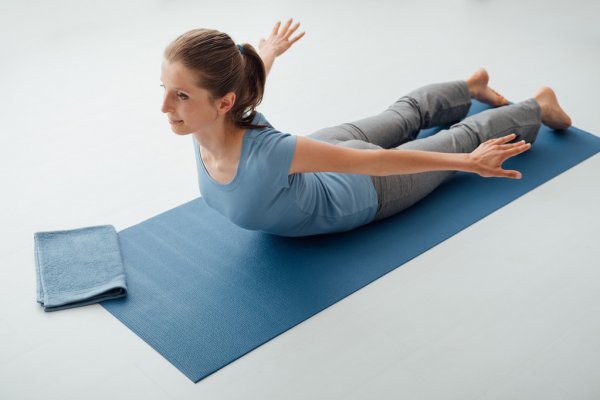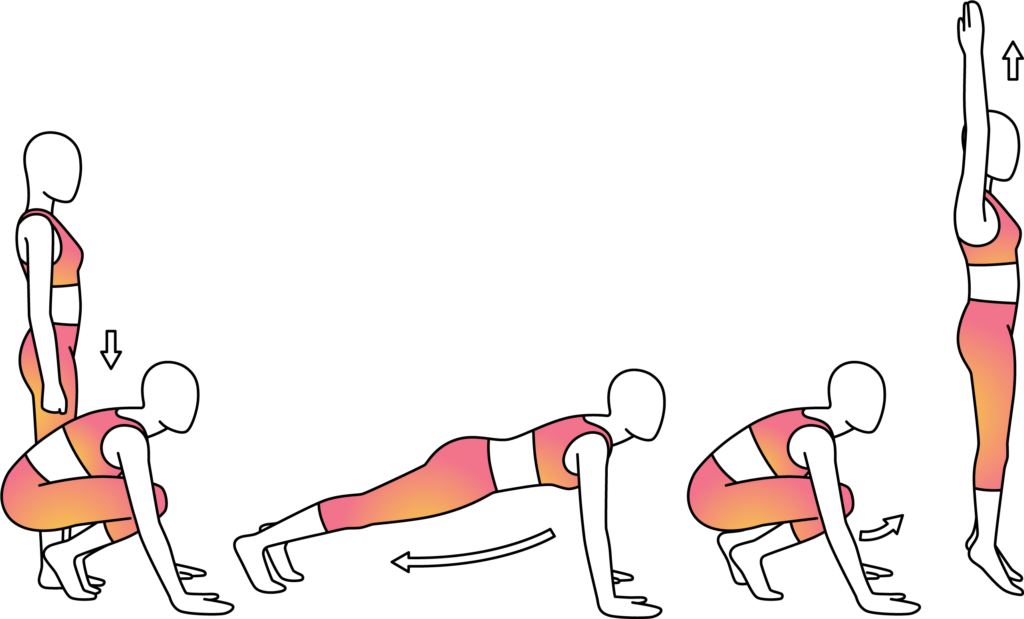How To Exercise If You Work From Home
If you’re reading this, 99% chance* that your lifestyle is mostly sedentary with little to no physical activity on business days.
*The number may or may not be the result of our flight of fancy ????
And if there’s anything that increases the chance of not moving enough, then it’s the pandemics and an IT-related job. Both these things enable us to work remotely for most of the part or even completely. As a result, the workers’ physical activity level falls dramatically. Recognize yourself yet?
What we need to do about it is find the right balance between sitting and moving. If we move enough, we become happier, and our health condition improves - all sorts of healthcare organizations, including big guys like the WHO, confirm it.
In case you wonder why we need to exercise, here’s a statement:
Your brain is your body, too

It sounds evident, but we tend to forget this simple truth. Your brain needs proper care - not less (and maybe even more!) than the rest of your body. It requires an adequate blood supply for energy, which you can enhance via training. It also needs support in cell regeneration: physical exercise helps a great deal in it. And, of course, the more active a person is, the longer their body stays young, and that, in its turn, keeps their brain healthy and fully functioning.
Your break-from-work exercising
Always warm up!
Before you start a workout, you need to get your body ready for that. Pay special attention to it if you like exercising in the cold. Lack of preparation can cause aching in your joints and puts your cardiovascular system under too much stress.
Start with something simple and natural, like walking in place - it’s just as effective as walking on track. Increase your heart rate gradually, and don’t let it plummet after the workout. The key is to keep your activity graph smooth with no abrupt falls or jumps.

Your program for a quick break
Get up from your chair
Yes, you should. It helps everything - from your blood circulation to your spine - get back to normal. It’s the smallest thing you can do to give your body a break from the routine of sitting. You can also raise your hands and reach upwards to stretch your spine or reach behind your back.
If getting up is not an option, put your legs on the table so that they get some relaxation. Feel like a boss behind your desk!

Do some neck rolls
In fact, rolling per se is not a must. Try to touch your shoulder with your ear, turn your head from one side to another. Tilt your chin towards your chest, but avoid tilting far back - it can be harmful to your backbone. For other directions, make sure you go all the way but don’t rush.

It’s okay to do it while sitting, too; so, there’s no excuse not to do it (of course, unless your medical recommendations say otherwise).
Wrist twist time
This one also works just fine when you’re at your desk, but we still recommend you to stand up. Reach with your arms forward or to the sides and start rotating them in one direction, then in another. Curl up your fingers to make a fist and forcefully uncurl them - repeat 10 times or more. Extend your arms forward, palms up, point your left hand down and press it with your right hand until you feel a slight stretch. Or just do this:

Nothing left behind - especially your behind
One of the areas that are under the most stress when you’re sitting is the lower back. Your glutes experience not stress, surprisingly enough - more like a lack of it. Both things result in unhealthy changes in your body posture, which can lead to more serious problems with your spine.
It’s great if you can lie down on a foam mat or a carpet; if so, you can do rotational stretching. Lie facing up, your knees bent, feet flat on the floor. Without moving the upper part of your body, turn your legs so that the knees touch the flor on the left from you. Then, bring them back up and turn likewise to the right. Do it slowly and hold the curled position for about 10 seconds each turn (just 3 of them will be enough).
You can do a similar stretch seated - just turn to one side with the upper part of your body, helping with the opposite arm. Remember to keep your back straight and your thighs fixed on the chair. It gets a bit tricky if you have a rotating chair. Choose a different one if possible; otherwise, the exercise will make little sense.
Standing up or on your knees, do a cat stretch. It’s important to feel the stretch itself - try to reach with your back as far up as possible.

How often?
The best approach would be to do a set of these exercises every hour. Just 5-10 minutes is enough to improve your health - isn’t that cool? You can also do different ones each time, so it doesn’t grow boring.
To stimulate yourself to exercise, keep something like a wrist builder on your desk. When your hands aren’t busy typing, you can squeeze it for a minute. No time wasted! And you can have more things at reach: for example, a massaging roll for your feet or a ball you can squeeze with your thighs.

"Do I need to devote my lunch breaks to CrossFit?"
No, it’s not necessary. To some of us, pairing work and hardcore exercising can increase stress levels dramatically. Take it easy - unless you feel perfectly comfortable (both physically and psychologically) with training that wears you out.
They say solving mathematical problems while running increases neuron production. But it doesn’t mean you should contemplate work-related brain busters on a treadmill. Again, awesome if you can! But if it’s too much pressure, leave it for better times.
Move all the hard stuff to the time before or after work. It’s great if you can leave at least half an hour between the two so that it’s easier for you to switch from one to another.
Your workday breaks are perfect for light shake-ups. It would be enough to just get up and stretch a little or walk for 5-10 minutes, preferably outside. When your schedule is too tight and doesn’t allow for walking out, you can do a few squats, jump or do anything else that doesn’t involve pain and excessive effort.
Take a look at these 33 Deskcersises with adorable names - that can also be a fun part of your daily routine.
Your workout program
Perfect timing
To begin with, decide when it’s the best time for you to start. Morning exercises are a human version of the Power On button: they activate the body and set the mind onto the working track. Work out in the morning when you feel not energetic enough to begin your workday or when you can’t pull your thoughts together.
Exercises in the evening should be the exact opposite. The later part of the day is for relaxation, for getting the work-related problems off your mind. If you feel like you really need it in the middle of the day, then do it. Only keep in mind that the longer break for a workout you take, the farther your thoughts float away from work. It can be helpful just as well as it can distract you too much.
NB: everyone has energy peaks and falls at different times of the day. Yes, you can train hard after the workday is over, but only if it won’t be some additional stress for you. And the same is for the lunch-break exercising.
Workout exercises
Before you begin, warm up. Prepare all the weights you’re willing to use if you go hard. It can even be a thick dictionary or a big bottle of water - anything goes!
Disclaimer: You may note that we don’t mention several other areas of the human body. However, it doesn’t mean you shouldn’t work on those muscles. Go above and beyond - your body will appreciate it! It’s just that these parts of your body suffer the most from the lifestyle of a home office worker.
Upper body
For your neck, the necessary and sufficient will be ensuring you move it enough. Flex it while warming up, and pay attention to that area during your quick everyday exercises. If you want to go further, work on your dumbbell - all sorts of shrugs, rows and similar exercises will be perfect.

Alternative by difficulty level:
- Easier - neck rolls, shrugs with no weight
- Similar - lateral raise
- Harder - heavy weight lifting
Core
This part of the workout is responsible for building a strong support system for your spine. In contrast to the common belief, this involves not only the muscles of your back. Here, you should work on your entire core: everything from your chest down, excluding the limbs.
Strengthen your back by holding a plank or a floor jack (or its twin known as the locust pose). That’s the way to feel every second! It would be awesome to stay in the position for about a minute, but you can figure out your timing.

Alternative by difficulty level:
- Easier - back extension; raise legs one by one
- Similar - quadrupled arm/leg raise
- Harder - add weight
One awesome exercise for your torso is a Russian twist. Sit on the floor, lift your feet and lean back a bit with your back straight. If you feel confident about your core muscles, take something in your hands and hold it in front of you. And start twisting your body!

Move only your torso - not your thighs, head or anything else. Try to hold the position for a minute or so - or until you feel it’s too much.
Alternative by difficulty level:
- Easier - crunches
- Similar - slow-paced mountain climber
- Harder - add weight; fast-paced mountain climber
Legs & buttocks
Your legs work the most when you lunge. It sounds simple: just move your weight to one leg and squat on it thrusting your body forward or to the side. But if you keep in mind every rule, it gets more difficult. To name a few: your back should be straight; all movement is two-dimensional rather than three (no leaning, curling, bending in any other direction); knee angles and the depth of the lunge should correspond with your target muscles - that’s a lot!

Jumping in between is not necessary, but it certainly enhances the effect on the muscles.
Alternative by difficulty level:
- Easier - no jumping; step-ups
- Similar - glute bridges
- Harder - add weight; donkey kicks with a resistance band
Another area we need to work on is the glutes. Your primary focus is split squats, or Bulgarian squats. Both seem relatively easy, but they can exhaust you when done right!
Split squats are squats on one leg, if we simplify it. Rest one foot behind on some box or chair - as if it were a bench. Another leg should be far enough for you to make a squat with a 90-degree angle in the knees.

Repeat it several times and switch legs.
Alternative by difficulty level:
- Easier - squats with a 90-degree angle in the knees; leg lifts
- Similar - glute bridges
- Harder - donkey kicks with a resistance band
All-inclusive exercises
Some training can employ most of your body muscles at the same time. The most well-known activity of that kind is running or its lighter version - walking. For those from the colder corners of our planet, skiing is a great option. For those who aren’t, there’s a combination of the two called Nordic walk.

If we talk home activity, you can do burpees or the mountain climber we mentioned above - they make your entire body work as nothing else does. Adjust the comfortable speed and off you go!

And when you feel too tired for an exhausting exercise like that, switch to jumping jacks. They don’t make you sweat like Burpees but still employ lots of your muscles.

P.S. While doing any exercises - and it counts for the ones we didn’t describe as well, keep control of your body. Feel which muscles you’re tensing and relaxing. That way, you’ll be aware of what you’re working on and regulate how much these parts are involved.
Do you do this right?
Lunges
One crucial rule about lunging: always do it with a proper body posture. Keeping your back straight is the only way to make all the muscles work the way they should and hurt nothing.
Depending on what you’re trying to achieve, you can do different types of lunges. If we simplify it to the absolute basics, you can employ three groups of muscles: frontal (quadriceps), backside (hamstrings and glutes), and calves.

Now, deeper into details: your glutes comprise three parts each, namely, max, med and min.

And you can choose which ones you activate. You just have to select the corresponding type of lunges. The most popular lunges, for one, make your maxes grow.

Squats
The first and foremost rule here is the same as for lunging - straighten your back. Keep your feet at a shoulder-length distance from each other. And work, work, work!
Similar to the lunges, different types of squats work your body in a different way. A single-leg squat is your workout for the gluteus minimus; regular squats are more for the quadriceps - choose your fighter, so to say. Add weight, hold position or squat deeper, and you’ll compensate for sitting a lot just fine.
By the way, isn’t that ridiculous how you need to imitate sitting to fight against the consequences of actual sitting? We had a laugh about that
Crunches
Lie down - preferably with your legs bent and feet on a couch, chair or anything else that allows a 90-degree angle in your knees. In the process, your back should look like an arch - no extra curve in your lower back!

Stretching
When you work on your muscle strength, don’t leave out exercises on flexibility. Rigid muscles aren’t a sign of healthy training. After (only after and never before) you worked out, stretch a bit while your body is still warmed up.
However, stretching doesn’t imply tearing yourself in halves. It’s better to do it slowly and gently and only up to the point where it doesn’t hurt too much. This is not a “no pain - no gain” situation: your goal is to freshen up and maintain healthy conditions, not to break world records.
Splits and bridge stretch aren’t natural for our bodies. If you can quite easily do it - fantastic, there you go! But if it’s painful and makes you really uncomfortable, please don’t go crazy on those exercises.

These things depend not only on how flexible your muscles are. Your bones and joints may simply not allow a certain amplitude, and that’s totally fine. In cases like that, stretching overly hard can damage your vertebrae, joints, ligaments and generally cause serious damage.
Many of such exercises make you apply too much pressure to your body. Some of them can be incredibly harmful when done wrong. Check out this one:

And it’s not only wrong because of the laptop. If you don’t do it exactly the right way, it can cause severe damage to your neck. We’d say such things are only for supervised training.
The cheat way to train
If you feel too lazy to do these things from our list, we’re with you on that: we do, too, at times. After all, what’s the point of the whole thing if it’s a torture and no fun?
The trick is to move - and it doesn’t have to be 100 Burpees or a marathon. Try this:
- Roll your neck: turn your head left and right, bend the neck forward lean it sideways.
- Make wrist rotations and stretches when you’re sitting and thinking over a problem. Also, check out other exercises we listed here: some of them require sitting!
- Draw circles with your feet while seating or tap the floor with your toes.
- Do a few leg raises; you could also sit for a bit with them on your desk.
- Get up and shake your body - you know, exactly how dogs do after they find the filthiest puddle and bathe in it.
- Tense and release your booty muscles (even if you’re sitting). A good time ratio is 1:2 - tense for two seconds and relax for four.
- Eye gymnastics are a breeze to do, too!
Multitask!
You may say that’s not a lazy thing to do. But if you combine things the right way, you can accomplish two things at once without significant effort. Instead of dusting your shelves after work, why not devote a couple of your 5-minute breaks to that? Thus, you get two things out of your way: you cleaned up a bit and got up to shake the stress of your muscles.
While washing or sanitizing your hands, rotate them and move them more forcefully than you regularly do. Hygiene and exercising - two for the price of one! The same goes for many other exercises. Instead of just standing in a line for a coffee, flex your ankles or roll from your heels to your toes.
The simplest and, at the same time, the hardest multitask exercising is trying to keep your posture straight while you’re sitting and walking. At the hairdresser’s, on the subway, in a restaurant - it does require a lot of concentration, but it pays off immeasurably.
“Passive” activity
"Waking up in the morning is enough of a challenge to add exercising to it..."

We totally get it! For cases like that, we recommend starting your day with stretching and a good yawn. Your alarm went off, and it’s time to get up, but the bed is so cozy… Stay in a bit! Stretch your back in any fashion that makes you feel good, then start moving your hands and feet. Flex your neck, tense any of your muscles - do anything you please without forcing yourself. Try to smile! That will both involve some more body parts into movement and make your morning a little happier.
Such lazy motion helps in all sorts of ways. It gets easier to wake up completely, you get some exercise, your brain activates - and the day begins healthy!
It’s not “do or die”
However good or bad you think your physical shape is, it doesn’t mean you have to go hard on exercising. You certainly can if that’s what you want, but no one makes you grow an Olympic star out of yourself.
You choose how much you follow our recommendations. Maybe you’re only okay with a half-hour workout once a week or a couple of simple intermittent exercises during a workday - that’s absolutely fine.
Remember: something is better than nothing! If you hate running, then don’t; if you know for sure that you’ll barely make yourself workout once a month, then be it. Do as much as you can - doing more is optional. And, of course, be tolerant with yourself: if you skip your workout once, it doesn’t mean you should give up completely. Just start where you left off as if nothing happened.
When you take a 5-minute activity break at work, it’s fantastic. But a serious workout during your lunch break is not always the best decision. Workplace cardio only increases heart and blood circulation problems due to lots of pressure you already had before training. So, maybe it’s better to exercise heavily only well after (or before) your workday.
Amp up the benefits
Maintain a healthy diet

The word diet appears so often in the context of losing weight that we sometimes forget it just implies your eating habits in general. You need to consume enough calories: even if you’re work from home, you still need them. Calculate your daily rate - we have a plugin for it - and try to stay within the norm, give or take 10%.
Talking of the reasonable amounts: drinking too much water is also not the healthiest thing to do. If you want to drink a lot, do it, but if you don’t - there’s no need to force another glass down the throat.
Avoid too hearty lunches when you work - it can reduce the efficiency of your cognitive processes for the time your body is digesting the food. Choose something well-balanced in terms of nutrients, and take portions of a reasonable size.
And that pesky sugar. We all have heard that sweet food is bad for you, but intellectual work consumes a lot of energy, and it happily takes sugar as a source. A cookie - preferably the healthy oatmeal type, is no sin. Just be mindful of how much sugar you consume.
Stay comfy
It’s not about the pep talks of leaving your comfort zone or finding one. It’s more about your physical comfort. Things like temperature, humidity, lighting and AC in your room have a dramatic effect on your health. Set your ambiance to your utmost comfort, wear comfortable clothes - and, of course, remember all along that you need to work, not relax. But make your workplace your favorite place to be.
Think of your workplace equipment, too. Does your chair support your back? Can you adjust it to the height of your desk? That would help prevent an unwanted curvature of your spine. Maybe your desk is also adjustable? If you can make it fit to working in a standing position, do it once in a while during your day. Alternatively, you can stand up while doing something that doesn’t require sitting, like making phone calls.
Keep track of your success
It’s impressive how empowering it feels when you visualize the work done. When you did something you’re proud of or achieved a certain result, mark it somewhere you can see it. Various apps can help you with it.
Fitness trackers show how you managed today in maintaining a reasonable activity level. If you haven’t had any experience with them, try! Seeing the actual numbers makes you want to move on with doing the right thing.
And the last word of advice
You’re the one to identify your best strategy. Use any of our recommendations in any combination, just be sure to stay as active as you can - it’s highly important for us sedentary lifestyle people.











